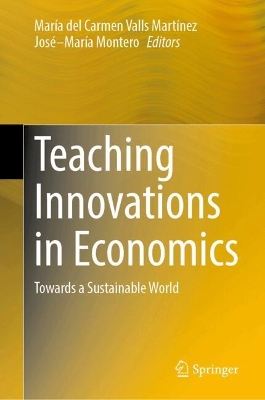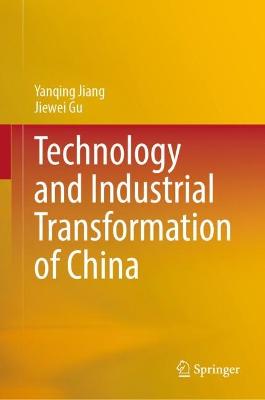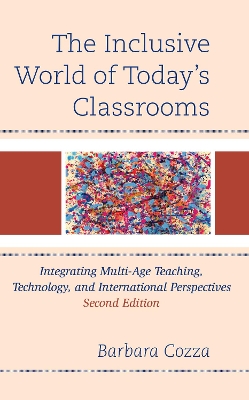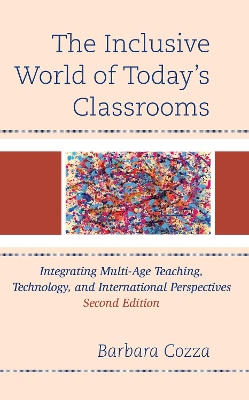Teaching Innovations in Economics
 portes grátis
portes grátis
Teaching Innovations in Economics
Towards a Sustainable World
Montero, Jose-Maria; Valls Martinez, Maria del Carmen
Springer International Publishing AG
12/2024
538
Dura
9783031725487
Pré-lançamento - envio 15 a 20 dias após a sua edição
Descrição não disponível.
Introduction.- Part I-New Teaching-Learning Models in Economic Education.- Chapter 1. Pedagogical Framework Targeting the Enhancement of Instruction in Quantitative Economic and Business disciplines.- Chapter 2. Enhancing Teaching Innovations in Business Administration and Management Through Interdisciplinary Coordination in Quantitative Subjects.- Chapter 3. Enhancing Visual Literacy and Data Analysis Skills in Macroeconomics Education: A Beveridge Curve Analysis Using FRED (R) Data.- Chapter 4. Methodology for Analyzing Educational Forums with NLP: Searching for Economic Terms.- Chapter 5. Adaptive Self-Assessment through the Virtual Campus: A Tool to Improve the Teaching-Learning Process.- Part II-Sustainable Development Goals. Sustainability in Economics Teaching.- Chapter 6. Uncovering the Impact of Developing a Sustainability Mindset on Business and Economics Students' Motivation to Learn about the Sustainable Development Goals.- Chapter 7. Sustainability Reports in the Classroom.- Chapter 8. Education on Sustainability and Sustainable Development Goals in University Teaching through Community Service Delivery.- Chapter 9. 2030 Agenda and Sustainable Learning: Access to Justice as an Instrument of Guarantee in the Face of the Social Inequalities of Globalisation.- Chapter 10. Climate Change and Emissions Rights: Teaching Experience Using Artificial Intelligence Tools.- Part III-Technology and Innovation in Economics Education.- Chapter 11. Generative Artificial Intelligence in Education: Risks and Opportunities.- Chapter 12. Acceptance of Technological Innovations in Economic Education: Key Factors for Implementation.- Chapter 13. SADMER: A System to Aid the Teaching of Econometric Modeling Using the R Language.- Chapter 14. Scientometrics, Data Science and Teaching Innovations in Economics. Reality or Utopia?.- Part IV-Methodologies and Tools for Active Learning.- Chapter 15. Enhancing Learning in Family Business Management through Art: Integrating Creative Methodologies in Higher Education.- Chapter 16. Peer-to-Peer Training in UAM Economics Faculty to Increase Scores and Motivation, Lower Defection Rates and Boost Employability in the Economy-Business Field.- Chapter 17. Improving Active Learning: Innovation in Statistics Education.- Chapter 18. Exploring the Impact of Problem-Based Learning on the Emotions of Business Administration and Management Students.- Chapter 19. Autonomous Collaborative Learning: Topic Development and Oral Presentation.- Part V-Gamification as a Teaching Methodology.- Chapter 20. The Implication of Expected Grades in the Evaluation of Traditional Pedagogical Materials and Gamification.- Chapter 21. Gamification, Learning and Satisfaction: An Empirical Approach.- Chapter 22. Strengthening Higher Education for Sustainable Development: Gamification and SDG 16.- Chapter 23. Development of Practical Skills in Probability: A Teaching Innovation Project to Make Applied Economics More Fun with Games of Chance.- Chapter 24. Applying a Gamification Technique for Learning Sustainable Finance.- Part VI-Curriculum Design.- Chapter 25. Field Work: Designing a Professionalising Master's Degree in Honduras.- Chapter 26. Attitudes towards Statistics in Business and Economic Studies: Implications for Teaching Innovation in Undergraduate Education.- Chapter 27. Strategies for Innovative Teaching of Entrepreneurship Skills: Developing Business Plans for Undergraduate Final Year Projects.- Chapter 28. The Project for Innovation and Improvement of External Internships in the Faculty of Social Sciences of the University of Castilla-La Mancha at Cuenca.
Este título pertence ao(s) assunto(s) indicados(s). Para ver outros títulos clique no assunto desejado.
Teaching Innovation;Digital Education;Artificial Intelligence;Educational Technology;Economics Education;Educational Progress;Learning Methodologies;Economics Learning;E-learning
Introduction.- Part I-New Teaching-Learning Models in Economic Education.- Chapter 1. Pedagogical Framework Targeting the Enhancement of Instruction in Quantitative Economic and Business disciplines.- Chapter 2. Enhancing Teaching Innovations in Business Administration and Management Through Interdisciplinary Coordination in Quantitative Subjects.- Chapter 3. Enhancing Visual Literacy and Data Analysis Skills in Macroeconomics Education: A Beveridge Curve Analysis Using FRED (R) Data.- Chapter 4. Methodology for Analyzing Educational Forums with NLP: Searching for Economic Terms.- Chapter 5. Adaptive Self-Assessment through the Virtual Campus: A Tool to Improve the Teaching-Learning Process.- Part II-Sustainable Development Goals. Sustainability in Economics Teaching.- Chapter 6. Uncovering the Impact of Developing a Sustainability Mindset on Business and Economics Students' Motivation to Learn about the Sustainable Development Goals.- Chapter 7. Sustainability Reports in the Classroom.- Chapter 8. Education on Sustainability and Sustainable Development Goals in University Teaching through Community Service Delivery.- Chapter 9. 2030 Agenda and Sustainable Learning: Access to Justice as an Instrument of Guarantee in the Face of the Social Inequalities of Globalisation.- Chapter 10. Climate Change and Emissions Rights: Teaching Experience Using Artificial Intelligence Tools.- Part III-Technology and Innovation in Economics Education.- Chapter 11. Generative Artificial Intelligence in Education: Risks and Opportunities.- Chapter 12. Acceptance of Technological Innovations in Economic Education: Key Factors for Implementation.- Chapter 13. SADMER: A System to Aid the Teaching of Econometric Modeling Using the R Language.- Chapter 14. Scientometrics, Data Science and Teaching Innovations in Economics. Reality or Utopia?.- Part IV-Methodologies and Tools for Active Learning.- Chapter 15. Enhancing Learning in Family Business Management through Art: Integrating Creative Methodologies in Higher Education.- Chapter 16. Peer-to-Peer Training in UAM Economics Faculty to Increase Scores and Motivation, Lower Defection Rates and Boost Employability in the Economy-Business Field.- Chapter 17. Improving Active Learning: Innovation in Statistics Education.- Chapter 18. Exploring the Impact of Problem-Based Learning on the Emotions of Business Administration and Management Students.- Chapter 19. Autonomous Collaborative Learning: Topic Development and Oral Presentation.- Part V-Gamification as a Teaching Methodology.- Chapter 20. The Implication of Expected Grades in the Evaluation of Traditional Pedagogical Materials and Gamification.- Chapter 21. Gamification, Learning and Satisfaction: An Empirical Approach.- Chapter 22. Strengthening Higher Education for Sustainable Development: Gamification and SDG 16.- Chapter 23. Development of Practical Skills in Probability: A Teaching Innovation Project to Make Applied Economics More Fun with Games of Chance.- Chapter 24. Applying a Gamification Technique for Learning Sustainable Finance.- Part VI-Curriculum Design.- Chapter 25. Field Work: Designing a Professionalising Master's Degree in Honduras.- Chapter 26. Attitudes towards Statistics in Business and Economic Studies: Implications for Teaching Innovation in Undergraduate Education.- Chapter 27. Strategies for Innovative Teaching of Entrepreneurship Skills: Developing Business Plans for Undergraduate Final Year Projects.- Chapter 28. The Project for Innovation and Improvement of External Internships in the Faculty of Social Sciences of the University of Castilla-La Mancha at Cuenca.
Este título pertence ao(s) assunto(s) indicados(s). Para ver outros títulos clique no assunto desejado.







